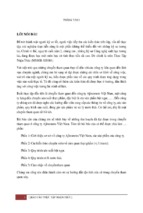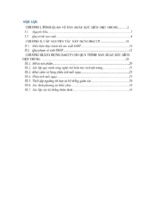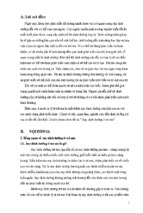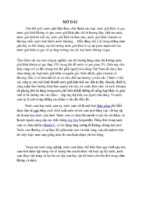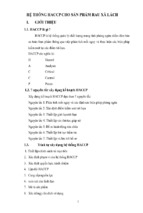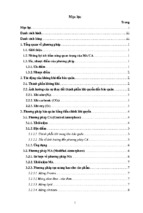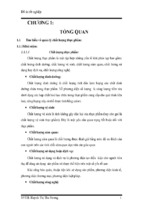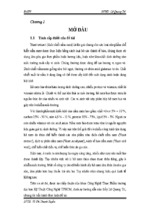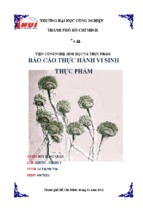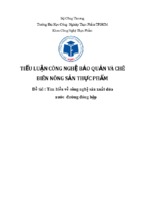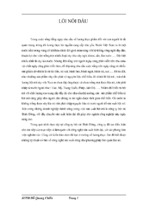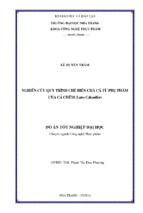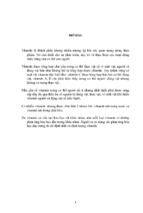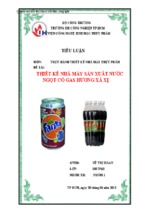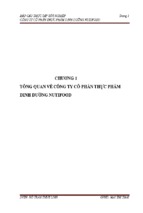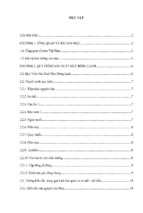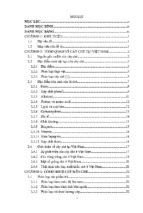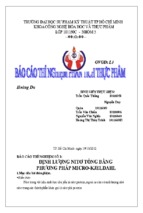A STUDY ON MACHINE TRANSLATION FOR
LOW-RESOURCE LANGUAGES
By TRIEU, LONG HAI
submitted to
Japan Advanced Institute of Science and Technology,
in partial fulfillment of the requirements
for the degree of
Doctor of Philosophy
Written under the direction of
Associate Professor Nguyen Minh Le
September, 2017
A STUDY ON MACHINE TRANSLATION FOR
LOW-RESOURCE LANGUAGES
By TRIEU, LONG HAI (1420211)
A thesis submitted to
School of Information Science,
Japan Advanced Institute of Science and Technology,
in partial fulfillment of the requirements
for the degree of
Doctor of Information Science
Graduate Program in Information Science
Written under the direction of
Associate Professor Nguyen Minh Le
and approved by
Associate Professor Nguyen Minh Le
Professor Satoshi Tojo
Professor Hiroyuki Iida
Associate Professor Kiyoaki Shirai
Associate Professor Ittoo Ashwin
July, 2017 (Submitted)
c 2017 by TRIEU, LONG HAI
Copyright
Acknowledgements
Abstract
Current state-of-the-art machine translation methods are neural machine translation and
statistical machine translation, which based on translated texts (bilingual corpora) to
learn translation rules automatically. Nevertheless, large bilingual corpora are unavailable
for most languages in the world, called low-resource languages, that cause a bottleneck for
machine translation (MT). Therefore, improving MT on low-resource languages becomes
one of the essential tasks in MT currently.
In this dissertation, I present my proposed methods to improve MT on low-resource
languages by two strategies: building bilingual corpora to enlarge training data for MT
systems and exploiting existing bilingual corpora by using pivot methods. For the first
strategy, I proposed a method to improve sentence alignment based on word similarity
learnt from monolingual data to build bilingual corpora. Then, a multilingual parallel
corpus was built using the proposed method to improve MT on several Southeast Asian
low-resource languages. Experimental results showed the effectiveness of the proposed
alignment method to improve sentence alignment and the contribution of the extracted
corpus to improve MT performance. For the second strategy, I proposed two methods
based on semantic similarity and using grammatical and morphological knowledge to improve conventional pivot methods, which generate source-target phrase translation using
pivot language(s) as the bridge from source-pivot and pivot-target bilingual corpora. I conducted experiments on low-resource language pairs such as the translation from Japanese,
Malay, Indonesian, and Filipino to Vietnamese and achieved promising results and improvement. Additionally, a hybrid model was introduced that combines the two strategies
to further exploit additional data to improve MT performance. Experiments were conducted on several language pairs: Japanese-Vietnamese, Indonesian-Vietnamese, MalayVietnamese, and Turkish-English, and achieved a significant improvement. In addition, I
utilized and investigated neural machine translation (NMT), the state-of-the-art method
in machine translation that has been proposed currently, for low-resource languages. I
compared NMT with phrase-based methods on low-resource settings, and investigated
how the low-resource data affects the two methods. The results are useful for further development of NMT on low-resource languages. I conclude with how my work contributes to
current MT research especially for low-resource languages and enhances the development
of MT on such languages in the future.
Keywords: machine translation, phrase-based machine translation, neural-based machine translation, low-resource languages, bilingual corpora, pivot translation, sentence
alignment
2
Acknowledgements
For three years working on this topic, it is my first long journey that attract me to the
academic area. It is also one of the biggest challenges that I have ever dealt with. This
work gives me a lot of interesting knowledge and experiences as well as difficulties that
require me with the best efforts. At the moment of writing this dissertation as a summary
for the PhD journey, it reminds me a lot of support from many people. This work cannot
be completed without their support.
First of all, I would like to thank my supervisor, Associate Professor Nguyen Minh Le.
Professor Nguyen gives me a lot of comments, advices, discussions in my whole three-year
journey from the starting point when I approached this topic without any prior knowledge
about machine translation until my last tasks to complete my dissertation and research.
Doing PhD is one of the most interesting things in studying, but it is also one of the most
challenge things for everyone in the academic career. Thanks to the useful and interesting
discussions with professor Nguyen, I have overcome the most difficult periods in doing
this research. Not only teach me some first lessons and skills in doing research, professor
Nguyen also has interesting and useful discussions that help me a lot in both studying
and the life.
I would like to thank the committee: Professor Satoshi Tojo, Professor Hiroyuki Iida,
Associate Professor Ittoo Ashwin, Associate Professor Kiyoaki Shirai for their comments.
This can be one of the first work in my academic career, that cannot avoid a lot of mistakes
and weaknesses. By discussing with the professors in the committee, and receiving their
valuable comments, they help me a lot in improving this dissertation.
I also would like to thank my collaborators: Associate Professor Nguyen Phuong Thai
for his comments, advices, and experience in sentence alignment and machine translation.
I would like to thank Vu Tran, Tin Pham, Viet-Anh Phan for their interesting discussions
and collaborations in doing some topics in this research. Thanks so much to Vu Tran,
Chien Tran for their technical support.
I would like to thank my colleagues and friends, Truong Nguyen, Huy Nguyen, for
their support and encourage. I also would like to give a special thank to professor JeanChristophe Terrillon Georges for his advices and comments on the writing skills and English manuscripts of my papers, special thank to professor Ho Tu Bao for valuable advices
in research. Thanks so much to Danilo S. Carvalho, Tien Nguyen for their comments.
Last but not least, I would like to thank my parents, Thi Trieu, Phuong Hoang, my
sister Ly Trieu, and my wife Xuan Dam for their support and encouragement in all time
not only in this work but in my life.
3
4
Table of Contents
Abstract
1
Acknowledgements
1
Table of Contents
3
List of Figures
4
List of Tables
6
1 Introduction
1.1 Machine Translation . . . . . . .
1.2 MT for Low-Resource Languages
1.3 Contributions . . . . . . . . . . .
1.4 Dissertation Outline . . . . . . .
.
.
.
.
.
.
.
.
.
.
.
.
.
.
.
.
2 Background
2.1 Statistical Machine Translation . . . . .
2.1.1 Phrase-based SMT . . . . . . . .
2.1.2 Language Model . . . . . . . . .
2.1.3 Metric: BLEU . . . . . . . . . . .
2.2 Sentence Alignment . . . . . . . . . . . .
2.2.1 Length-Based Methods . . . . . .
2.2.2 Word-Based Methods . . . . . . .
2.2.3 Hybrid Methods . . . . . . . . . .
2.3 Pivot Methods . . . . . . . . . . . . . .
2.3.1 Definition . . . . . . . . . . . . .
2.3.2 Approaches . . . . . . . . . . . .
2.3.3 Triangulation: The Representative
2.3.4 Previous work . . . . . . . . . . .
2.4 Neural Machine Translation . . . . . . .
.
.
.
.
.
.
.
.
.
.
.
.
.
.
.
.
.
.
.
.
.
.
.
.
. . . . . .
. . . . . .
. . . . . .
. . . . . .
. . . . . .
. . . . . .
. . . . . .
. . . . . .
. . . . . .
. . . . . .
. . . . . .
Approach
. . . . . .
. . . . . .
.
.
.
.
.
.
.
.
.
.
.
.
.
.
.
.
7
7
8
8
9
. . . . . . . . . .
. . . . . . . . . .
. . . . . . . . . .
. . . . . . . . . .
. . . . . . . . . .
. . . . . . . . . .
. . . . . . . . . .
. . . . . . . . . .
. . . . . . . . . .
. . . . . . . . . .
. . . . . . . . . .
in Pivot Methods
. . . . . . . . . .
. . . . . . . . . .
.
.
.
.
.
.
.
.
.
.
.
.
.
.
.
.
.
.
.
.
.
.
.
.
.
.
.
.
.
.
.
.
.
.
.
.
.
.
.
.
.
.
11
11
12
13
13
14
14
14
15
16
16
16
16
18
19
.
.
.
.
.
.
.
.
.
.
.
.
.
.
.
.
.
.
.
.
.
.
.
.
.
.
.
.
.
.
.
.
.
.
.
.
3 Building Bilingual Corpora
21
3.1 Dealing with Out-Of-Vocabulary Problem . . . . . . . . . . . . . . . . . . 22
3.1.1 Word Similarity Models . . . . . . . . . . . . . . . . . . . . . . . . 22
1
TABLE OF CONTENTS
.
.
.
.
.
.
.
.
.
.
.
.
.
.
.
.
.
.
.
.
.
.
.
.
.
.
.
.
.
.
.
.
.
.
.
.
.
.
.
.
.
.
.
.
.
.
.
.
.
.
.
.
.
.
.
.
.
.
.
.
23
24
26
27
29
30
32
33
34
40
4 Pivoting Bilingual Corpora
4.1 Semantic Similarity for Pivot Translation . . . . . . . . . . . . . .
4.1.1 Semantic Similarity Models . . . . . . . . . . . . . . . . .
4.1.2 Semantic Similarity for Triangulation . . . . . . . . . . . .
4.1.3 Experiments on Japanese-Vietnamese . . . . . . . . . . . .
4.1.4 Experiments on Southeast Asian Languages . . . . . . . .
4.2 Grammatical and Morphological Knowledge for Pivot Translation
4.2.1 Grammatical and Morphological Knowledge . . . . . . . .
4.2.2 Combining Features to Pivot Translation . . . . . . . . . .
4.2.3 Experiments . . . . . . . . . . . . . . . . . . . . . . . . . .
4.2.4 Analysis . . . . . . . . . . . . . . . . . . . . . . . . . . . .
4.3 Pivot Languages . . . . . . . . . . . . . . . . . . . . . . . . . . .
4.3.1 Using Other Languages for Pivot . . . . . . . . . . . . . .
4.3.2 Rectangulation for Phrase Pivot Translation . . . . . . . .
4.4 Conclusion . . . . . . . . . . . . . . . . . . . . . . . . . . . . . . .
.
.
.
.
.
.
.
.
.
.
.
.
.
.
.
.
.
.
.
.
.
.
.
.
.
.
.
.
.
.
.
.
.
.
.
.
.
.
.
.
.
.
.
.
.
.
.
.
.
.
.
.
.
.
.
.
.
.
.
.
.
.
.
.
.
.
.
.
.
.
41
42
42
43
45
47
50
50
52
53
56
69
69
70
70
3.2
3.3
3.1.2 Improving Sentence Alignment Using Word Similarity
3.1.3 Experiments . . . . . . . . . . . . . . . . . . . . . . .
3.1.4 Analysis . . . . . . . . . . . . . . . . . . . . . . . . .
Building A Multilingual Parallel Corpus . . . . . . . . . . .
3.2.1 Related Work . . . . . . . . . . . . . . . . . . . . . .
3.2.2 Methods . . . . . . . . . . . . . . . . . . . . . . . . .
3.2.3 Extracted Corpus . . . . . . . . . . . . . . . . . . . .
3.2.4 Domain Adaptation . . . . . . . . . . . . . . . . . . .
3.2.5 Experiments on Machine Translation . . . . . . . . .
Conclusion . . . . . . . . . . . . . . . . . . . . . . . . . . . .
.
.
.
.
.
.
.
.
.
.
.
.
.
.
.
.
.
.
.
.
5 Combining Additional Resources to Enhance SMT for Low-Resource
Languages
5.1 Enhancing Low-Resource SMT by Combining Additional Resources . . . .
5.2 Experiments on Japanese-Vietnamese . . . . . . . . . . . . . . . . . . . . .
5.2.1 Training Data . . . . . . . . . . . . . . . . . . . . . . . . . . . . . .
5.2.2 Training Details . . . . . . . . . . . . . . . . . . . . . . . . . . . . .
5.2.3 Main Results . . . . . . . . . . . . . . . . . . . . . . . . . . . . . .
5.3 Experiments on Southeast Asian Languages . . . . . . . . . . . . . . . . .
5.3.1 Training Data . . . . . . . . . . . . . . . . . . . . . . . . . . . . . .
5.3.2 Training Details . . . . . . . . . . . . . . . . . . . . . . . . . . . . .
5.3.3 Main Results . . . . . . . . . . . . . . . . . . . . . . . . . . . . . .
5.4 Experiments on Turkish-English . . . . . . . . . . . . . . . . . . . . . . . .
5.4.1 Training Data . . . . . . . . . . . . . . . . . . . . . . . . . . . . . .
5.4.2 Training Details . . . . . . . . . . . . . . . . . . . . . . . . . . . . .
5.4.3 Results . . . . . . . . . . . . . . . . . . . . . . . . . . . . . . . . . .
5.5 Analysis . . . . . . . . . . . . . . . . . . . . . . . . . . . . . . . . . . . . .
5.5.1 Exploiting Informative Vocabulary . . . . . . . . . . . . . . . . . .
2
72
72
74
74
74
75
77
77
77
77
79
79
80
80
82
82
TABLE OF CONTENTS
5.6
5.5.2 Sample Translations . . . . . . . . . . . . . . . . . . . . . . . . . . 83
Conclusion . . . . . . . . . . . . . . . . . . . . . . . . . . . . . . . . . . . . 86
6 Neural Machine Translation for Low-Resource Languages
6.1 Neural Machine Translation . . . . . . . . . . . . . . . . . . . . . . . . .
6.1.1 Attention Mechanism . . . . . . . . . . . . . . . . . . . . . . . . .
6.1.2 Byte-pair Encoding . . . . . . . . . . . . . . . . . . . . . . . . . .
6.2 Phrase-based versus Neural-based Machine Translation on Low-Resource
Languages . . . . . . . . . . . . . . . . . . . . . . . . . . . . . . . . . . .
6.2.1 Setup . . . . . . . . . . . . . . . . . . . . . . . . . . . . . . . . .
6.2.2 SMT vs. NMT on Low-Resource Settings . . . . . . . . . . . . . .
6.2.3 Improving SMT and NMT Using Comparable Data . . . . . . . .
6.3 A Discussion on Transfer Learning for Low- Resource Neural Machine
Translation . . . . . . . . . . . . . . . . . . . . . . . . . . . . . . . . . .
6.4 Conclusion . . . . . . . . . . . . . . . . . . . . . . . . . . . . . . . . . . .
7 Conclusion
88
. 88
. 89
. 89
.
.
.
.
89
90
90
93
. 94
. 95
96
3
List of Figures
2.1
2.2
Pivot alignment induction . . . . . . . . . . . . . . . . . . . . . . . . . . . 18
Recurrent architecture in neural machine translation . . . . . . . . . . . . 19
3.1
3.2
3.3
Word similarity for sentence alignment . . . . . . . . . . . . . . . . . . . . 23
Experimental results on the development and test sets . . . . . . . . . . . 36
SMT vs NMT in using the Wikipedia corpus . . . . . . . . . . . . . . . . . 39
4.1
4.2
4.3
4.4
Semantic similarity for pivot translation
Pivoting using syntactic information . .
Pivoting using morphological information
Confidence intervals . . . . . . . . . . . .
5.1
A combined model for SMT on low-resource languages . . . . . . . . . . . 73
4
.
.
.
.
.
.
.
.
.
.
.
.
.
.
.
.
.
.
.
.
.
.
.
.
.
.
.
.
.
.
.
.
.
.
.
.
.
.
.
.
.
.
.
.
.
.
.
.
.
.
.
.
.
.
.
.
.
.
.
.
.
.
.
.
.
.
.
.
.
.
.
.
.
.
.
.
44
51
52
59
List of Tables
3.1
3.2
3.3
3.4
3.5
3.6
3.7
3.8
3.9
3.10
3.11
3.12
3.13
3.14
3.15
3.16
3.17
3.18
3.19
3.20
English-Vietnamese sentence alignment test data set . . . . . . . . . . . .
IWSLT15 corpus for training word alignment . . . . . . . . . . . . . . . . .
English-Vietnamese alignment results . . . . . . . . . . . . . . . . . . . . .
Sample English word similarity . . . . . . . . . . . . . . . . . . . . . . . .
Sample Vietnamese word similarity . . . . . . . . . . . . . . . . . . . . . .
OOV ratio in sentence alignment . . . . . . . . . . . . . . . . . . . . . . .
Sample English-Vietnamese alignment . . . . . . . . . . . . . . . . . . . .
English word similarity . . . . . . . . . . . . . . . . . . . . . . . . . . . . .
Sample IBM Model 1 . . . . . . . . . . . . . . . . . . . . . . . . . . . . . .
Induced word alignment . . . . . . . . . . . . . . . . . . . . . . . . . . . .
Wikipedia database dumps’ resources used to extract parallel titles . . . .
Extracted and processed data from parallel titles . . . . . . . . . . . . . .
Sentence alignment output . . . . . . . . . . . . . . . . . . . . . . . . . . .
Extracted Southeast Asian multilingual parallel corpus . . . . . . . . . . .
Monolingual data sets . . . . . . . . . . . . . . . . . . . . . . . . . . . . .
Experimental results on the development and test sets . . . . . . . . . . .
Data sets on the IWSLT 2015 experiments . . . . . . . . . . . . . . . . . .
Experimental results using phrase-based statistical machine translation . .
Experimental results on neural machine translation . . . . . . . . . . . . .
Comparison with other systems participated in the IWSLT 2015 shared task
25
25
26
27
27
28
28
28
29
29
30
31
32
32
33
35
37
38
39
40
4.1
4.2
4.3
4.4
4.5
4.6
4.7
4.8
4.9
4.10
4.11
4.12
4.13
Bilingual corpora for Japanese-Vietnamese pivot translation . . . . . . .
Japanese-Vietnamese development and test sets . . . . . . . . . . . . . .
Monolingual data sets of Japanese, English, Vietnamese . . . . . . . . . .
Japanese-Vietnamese pivot translation results . . . . . . . . . . . . . . .
Bilingual corpora of Southeast Asian language pairs . . . . . . . . . . . .
Bilingual corpora for pivot translation of Southeast Asian language pairs
Monolingual data sets of Indonesian, Malay, and Filipino . . . . . . . . .
Pivot translation results of Southeast Asian language pairs . . . . . . . .
Examples of grammatical information for pivot translation . . . . . . . .
Southeast Asian bilingual corpora for training factored models . . . . . .
Results of using POS and lemma forms . . . . . . . . . . . . . . . . . . .
Indonesian-Vietnamese results . . . . . . . . . . . . . . . . . . . . . . . .
Filipino-Vietnamese results . . . . . . . . . . . . . . . . . . . . . . . . . .
46
46
47
47
48
48
49
49
50
53
54
54
55
5
.
.
.
.
.
.
.
.
.
.
.
.
.
LIST OF TABLES
4.14
4.15
4.16
4.17
4.18
4.19
4.20
4.21
4.22
4.23
4.24
4.25
4.26
4.27
4.28
4.29
4.30
4.31
Input factored phrase tables . . . . . . . . . . . . . . . . . . . . .
Extracted phrase pairs by triangulation . . . . . . . . . . . . . . .
Out-Of-Vocabulary ratio . . . . . . . . . . . . . . . . . . . . . . .
Results of statistical significance tests . . . . . . . . . . . . . . . .
Experimental results on different metrics: BLEU, TER, METEOR
Ranks on different metrics . . . . . . . . . . . . . . . . . . . . . .
Spearman rank correlation between metrics . . . . . . . . . . . . .
Wilcoxon on Malay-Vietnamese . . . . . . . . . . . . . . . . . . .
Wilcoxon on Indonesian-Vietnamese . . . . . . . . . . . . . . . . .
Wilcoxon on Filipino-Vietnamese . . . . . . . . . . . . . . . . . .
Wilcoxon on Malay-Vietnamese . . . . . . . . . . . . . . . . . . .
Wilcoxon on Indonesian-Vietnamese . . . . . . . . . . . . . . . . .
Wilcoxon on Filipino-Vietnamese . . . . . . . . . . . . . . . . . .
Sample translations: POS and lemma factors for pivot translation
Sample translation: Indonesian-Vietnamese . . . . . . . . . . . . .
Sample translation: Filipino-Vietnamese . . . . . . . . . . . . . .
Using other languages for pivot . . . . . . . . . . . . . . . . . . .
Using rectangulation for phrase pivot translation . . . . . . . . . .
.
.
.
.
.
.
.
.
.
.
.
.
.
.
.
.
.
.
.
.
.
.
.
.
.
.
.
.
.
.
.
.
.
.
.
.
.
.
.
.
.
.
.
.
.
.
.
.
.
.
.
.
.
.
55
56
57
60
62
63
63
64
64
65
65
66
66
67
68
68
69
70
5.1
5.2
5.3
5.4
5.5
5.6
5.7
5.8
5.9
5.10
5.11
5.12
5.13
5.14
Japanese-Vietnamese results on the direct model . . . . . . . . . . . . .
Japanese-Vietnamese results on the combined models . . . . . . . . . .
Results of Japanese-Vietnamese on the big test set . . . . . . . . . . .
Results of statistical significance tests on Japanese-Vietnamese . . . . .
Southeast Asian results on the direct models . . . . . . . . . . . . . . .
Southeast Asian results on the combined model . . . . . . . . . . . . .
Bilingual corpora for Turkish-English pivot translation . . . . . . . . .
Experimental results on the Turkish-English . . . . . . . . . . . . . . .
Experimental results on the English-Turkish translation . . . . . . . . .
Building a bilingual corpus of Turkish-English from Wikipedia . . . . .
Dealing with out of vocabulary problem using the combined model . .
Sample translations: using the combined model (Japanese-Vietnamese)
Sample translations (Indonesian-Vietnamese, Malay-Vietnamese) . . . .
Sample translations: using the combined model (Filipino-Vietnamese) .
.
.
.
.
.
.
.
.
.
.
.
.
.
.
.
.
.
.
.
.
.
.
.
.
.
.
.
.
75
75
76
76
78
78
80
80
81
81
82
84
85
86
6.1
6.2
6.3
6.4
6.5
6.6
Bilingual data set of Japanese-English . . . . . . . . . . .
Experimental results in Japanese-English translation . . .
Bilingual data sets of Indonesian-Vietnamese . . . . . . . .
Experimental results on Indonesian-Vietnamese translation
Experimental results English-Vietnamese . . . . . . . . . .
English-Vietnamese results using the Wikipedia corpus . .
.
.
.
.
.
.
.
.
.
.
.
.
91
91
92
92
92
93
6
.
.
.
.
.
.
.
.
.
.
.
.
.
.
.
.
.
.
.
.
.
.
.
.
.
.
.
.
.
.
.
.
.
.
.
.
.
.
.
.
.
.
.
.
.
.
.
.
.
.
.
.
.
.
.
.
.
.
.
.
.
.
.
.
.
.
.
.
.
.
.
.
.
.
.
.
.
.
Chapter 1
Introduction
1.1
Machine Translation
Translation between languages is an important demand of humanity. With the advent
of digital computers, it provided a basis for the dream of building machines to translate
languages automatically. Almost as soon as electronic computers appeared, people made
efforts to build automatic systems for translation, which also opened a new field: machine
translation. As defined in Hutchins and Somers, 1992 [33], machine translation (MT)
is "computerized systems responsible for the production of translation from one natural
language to another, with or without human assistance".
Machine translation has a long history in its development. Various approaches were
explored such as: direct translation (using rules to map input to output), transfer methods
(analyzing syntactic and morphological information), and interlingual methods (using
representations of abstract meaning). The field attracted a lot of interest from community
like: a study of realities of machine translation from US funding agencies in 1966 (ALPAC
report), commercial systems from the past (Systran in 1968, Météo in 1976, Logos and
METAL in 1980s) to current development by large companies (IBM, Microsoft, Google),
and many projects in universities and academic institutes.
Dominated approaches of current machine translation are statistical machine translation
(SMT) and neural machine translation (NMT), which are based on resources of translated
texts, a trend of data-driven methods. Previous work cannot succeed with rule-based
methods when there are a large number of rules that were so complicated to discover,
represent, and transfer between languages. Instead of that, a set of translated texts are
used to automatically learn corresponding rules between languages. This trend has shown
state-of-the-art results in recent researches as well as applied in the current widely-used
MT system, Google.
Translated texts, called bilingual corpora, therefore become one of the key factors that
affect the translation quality. For more precisely, a bilingual corpus (parallel corpora or
bilingual corpora in plural) is a set of sentence pairs of two languages in which two sentences in each pair are the translation of each other. Current MT systems require large
bilingual corpora even up to millions of sentence pairs to learn translation rules. There
7
1.2. MT FOR LOW-RESOURCE LANGUAGES
are many efforts in building large bilingual corpora like Europarl (the bilingual corpus of
21 European languages), English-Arabic, English-Chinese. Building such large bilingual
corpora requires many efforts. Therefore, besides bilingual corpora of European languages
and some other language pairs, there are few large bilingual corpora for most language
pairs in the world. This issue leads to a bottleneck for machine translation in many language pairs that lack large bilingual corpora, called low-resource languages. In this work,
I define low-resource languages as language pairs that have no or small bilingual corpora
(less than one million sentence pairs). Improving MT on low-resource languages becomes
an essential task that demands many efforts as well as attracts many interest currently.
1.2
MT for Low-Resource Languages
In previous work, solutions have been proposed to deal with the problem of insufficient
bilingual corpora. There are two main strategies: building new bilingual corpora and utilizing existed corpora.
For the first strategy, bilingual corpora can be built manually or automatically. Building
large bilingual corpora by human may ensure the quality of corpora; however, it requires
a high cost of labor and time. Therefore, automatically building bilingual corpora can be
a feasible solution. This task relates to a sub-field: sentence alignment, in which sentences
that are translation of each other can be extracted automatically [5, 11, 27, 59, 92]. The
effectiveness of sentence alignment algorithms affect the quality of the bilingual corpora. In
this work, I have improved a problem in sentence alignment namely out-of-vocabulary, in
which there is insufficient knowledge of bilingual dictionary used for sentence alignment.
The proposed method was applied to build a bilingual corpus for several low-resource
language pairs and then used to improve MT performance.
For the second strategy, existing bilingual corpora can be utilized to extract translation
rules for a language pair called pivot methods. Specifically, pivot language(s) are used to
connect translation from a source language to a target language if there exist bilingual
corpora of source-pivot and pivot-target language pairs [16, 18, 91, 98].
1.3
Contributions
There are four main contributions of this dissertation.
First, I have improved a problem in sentence alignment to deal with the out-of-vocabulary
problem. In addition, a large multilingual parallel corpus was built to contribute for the development and improving MT on several low-resource language pairs of Southeast Asian:
Indonesian, Malay, Filipino, and Vietnamese that there is no prior work on these language
pairs.
Second, I propose two methods to improve pivot methods. The first method is to enhance pivot methods by semantic similarity to deal with the problem of lacking information of the conventional triangulation approach. The second method is to improve the
conventional triangulation approach by integrating grammatical and morphological knowl8
1.4. DISSERTATION OUTLINE
edge. The effectiveness of the proposed methods were confirmed by various experiments
on several language pairs.
Third, I propose a hybrid model that significantly improves MT on low-resource languages by combining the two strategies of building bilingual corpora and exploiting existing bilingual corpora. Experiments were conducted on three different language pairs:
Japanese-Vietnamese, Southeast Asian languages, and Turkish-English to evaluate the
proposed method.
Fourth, several empirical investigations were conducted on low-resource language pairs
using NMT to provide some empirical basis that is useful for further improvement of this
method in the future for low-resource languages.
1.4
Dissertation Outline
Although MT has shown significant improvement recently, there is still a big issue that
requires many efforts in MT: improving MT for low-resource languages because of insufficient training data, one of the key factors in current MT systems. In this thesis, I focus
on two main strategies: building bilingual corpora to enlarge training data for MT systems, and exploiting existing bilingual corpora based on pivot methods. I will spend two
chapters to describe my proposed methods for the two strategies. Then, one chapter is to
present my proposed model that can effectively combine and exploit the two strategies in
a hybrid model. Besides the two main strategies, I spend one chapter to present some of
my first investigations on utilizing NMT, a successful method recently, on low-resource
languages. I start my dissertation by providing necessary background knowledge in Chapter 2 for readers about methods presented in this dissertation. In chapter 3, I describe my
proposed methods to improve sentence alignment and a multilingual parallel corpus built
from comparable data.1 Chapter 4 presents my proposed methods in pivot translation
that include two main parts: applying semantic similarity; and integrating grammatical
and morphological information. In Chapter 5, I present a hybrid model that combines the
two strategies. Chapter 6 contains my investigations of utilizing NMT for low-resource
languages. Finally, I conclude my work in Chapter 7.
Building Bilingual Corpora Chapter 3 is my methods related to the strategy of
building bilingual corpora to enlarge the training data for MT, which includes two main
parts in this chapter. In the first section, I present my proposed method related to sentence
alignment using semantic similarity. Experimental results show the contribution of the
proposed method. This chapter is based on the paper (Trieu et al., 2016 [88]). The second
section is about building a multilingual parallel corpus from Wikipedia that can enhance
1
In addition, I also have a paper that is based on building a very large monolingual data to train
a large language model that significantly improves SMT systems. This system presented in the paper
(Trieu et al., 2015 [83]). In the IWSLT 2015 machine translation shared task, the system achieves the
state-of-the-art result in human evaluation for English-Vietnamese, and ranked the runner-up for the
automatic evaluation.
9
1.4. DISSERTATION OUTLINE
MT for several low-resource language pairs. This section is based on the paper (Trieu and
Nguyen, 2017 [87]).
Pivoting Bilingual Corpora Chapter 4 introduces my proposed methods related to
pivot translation. There are two main sections in this chapter that correlate to two proposed methods in improving the conventional pivot method. The first part presents my
proposed method to improve pivot translation using semantic similarity. This section is
based on the paper (Trieu and Nguyen, 2016 [84]). For the second part, I describe a proposed method that integrates grammatical and morphological to pivot translation. This
section is based on the paper (Trieu and Nguyen, 2017 [85]).
A Hybrid Model for Low-Resource Languages Chapter 5 presents my proposed
model that combines the two strategies: building bilingual corpora and exploiting existing
bilingual corpora that are described in the previous two chapters. This section is based on
the paper that I submitted to the ACM Transactions on Asian and Low-Resource Language
Information Processing (TALLIP). For the second part, I applied this model to TurkishEnglish that has shown the significant improvement in using the proposed model. This
section is based on the paper (Trieu et al., 2017 [89]).
NMT for Low-Resource Languages Chapter 6 presents my research in utilizing
NMT for low-resource languages in various language pairs. This can be a basis for further
improvement in the future for low-resource languages. This chapter is based on the paper
(Trieu and Nguyen, 2017 [86]).
All data, code, and models used in this dissertation are available at https://github.
com/nguyenlab/longtrieu-mt
10
Chapter 2
Background
In this chapter, I present necessary background knowledge of the main topic and methods
in this dissertation, which include: SMT, NMT, pivot methods, and sentence alignment.
2.1
Statistical Machine Translation
SMT is a class of approaches in machine translation that build probabilistic models to
choose the most probable translation. SMT is based on the Bayes noisy channel model as
follows.
Let F be a source-language sentence, and Ê be the best translation of F .
F = f1 , f2 , ..., fm
Ê = e1 , e2 , ..., el
The translation from F to Ê is modeled as follows.
Ê = argmaxE P (E|F ) = argmaxE
P (F |E)P (E)
= argmaxE P (F |E)P (E)
P (F )
(2.1)
There are three components in the models:
• P (F |E) called a translation model
• P (E) called a language model
• A decoder : a component produces the most probable E given F
For the translation model P (F |E), the probability that E generates F can be calculated
based on two ways: word-based (individual words), or phrase-based (sequences of words).
Phrase-based SMT (Koehn et al., 2003) [44] have showed the state-of-the-art performance
in machine translation for many language pairs (Bojar et al., 2013) [4].
11
2.1. STATISTICAL MACHINE TRANSLATION
2.1.1
Phrase-based SMT
Phrase-based SMT uses phrases (a sequence of consecutive words) as atomic units for
translation. The source sentence is segmented into a number of phrases. Each phrases is
then translated into a target phrase.
Given, f : source sentence; ebest : the best target translation. Then, ebest can be computed
as follows.
ebest = argmaxe p(e|f ) = argmaxe p(f |e)pLM (e)
(2.2)
where:
• pLM (e) :the language model
• p( f |e): the translation model
The translation model p( f |e) can be decomposed into:
p(f1−I |e−I
1 ) =
I
Y
φ(fi |ei )d(starti − endi−1 − 1)
(2.3)
i=1
where:
• The source sentence f is segmented into I phrases: fi
• Each source pharse fi is translated into a target phrase ei
• d(starti − endi−1 − 1) : reordering model; the output phrases can be reordered based
on a distance-based reordering model. Let starti be the first word’s position of
the source phrase that translates to the ith target phrase; endi be the last word’s
position of the source phrase; Then, the reordering distance can be calculated as
starti − endi−1 − 1.
Therefore, the phrase-based SMT model is formed as follows:
ebest = argmaxe
I
Y
φ(fi |ei )d(starti − endi−1 − 1)
|e|
Y
i=1
i=1
where: there are three components in the model
• the phrase translation table φ(fi |ei )
• the reordering model d
• the language model pLM (e)
12
pLM (ei |e1 ...ei−1 )
(2.4)
2.1. STATISTICAL MACHINE TRANSLATION
Tools For statistical machine translation, several tools have been introduced, which
showed the effectiveness and contributed to the development of the field. One of the most
well-known system is the phrase-based Moses toolkit [43]. Another toolkit based on
an n-gram-based statistical machine translation is Marie [53]. For integrating syntactic
information in statistical machine translation, Li et al., 2009 [47] introduced Joshua, an
open source decoder for statistical translation models based on synchronous context free
grammars. Neubig 2013 [61] presents a system called Travatar, a tree-to-string statistical
machine translation system. Dyer et al., 2010 introduced CDEC [22], a decoder, aligner,
and model optimizer for statistical machine translation and other structured prediction
models based on (mostly) context-free formalisms. In my work, since I focus on phrasebased machine translation, the powerful and well-known Moses toolkit was utilized in
experiments.
One of the core part in phrase-based models is the word alignment. The task can be
solved effectively by the system namely GIZA++ [65], an effective training algorithm for
alignment models.
2.1.2
Language Model
Language model is an essential component in the SMT model. Language model aims to
measure how likely it is that a sequence of words can be uttered by a native speaker is
the target language. A probabilistic language model pLM should show the correct word
order as in the following example:
pLM (the car is new) > pLM (new the is car)
A method is used in language models called n-gram language modeling. In order to
predict a word sequence W = w1 , w2 , ..., wn , the model predicts one word at a time.
p(w1 , w2 , ..., wn ) = p(w1 )p(w2 |w1 )...p(wn |w1 , w2 , ..., wn−1 )
(2.5)
The common language models used in machine translation are: trigram (the collection
of statistics over sequence of three words), or 5-grams. Some other kinds of n-gram
language model include: unigram (single word), bigram (2-grams or a sequence of two
words).
Tools For training language models, several effective systems have been proposed such
as: KenLM [31], SRILM [78], IRSTLM [24], and BerkeleyLM [38].
2.1.3
Metric: BLEU
The BLEU metric (BiLingual Evaluation Understudy) (Papineni et al., 2002) [66] is
one of the most popular automatic evaluation metrics, which are used for evaluation in
machine translation currently. The metric is based on matches of larger n-grams with the
reference translation.
13
2.2. SENTENCE ALIGNMENT
The BLEU is defined as follows as a model of precision-based metrics.
BLEU − n = brevity − penalty exp
n
X
λi log precisioni
(2.6)
i=1
brevity − penalty = min(1,
output_length
)
ref erence_length
(2.7)
where
• n: the maximum order for n-grams to be matched (typically set to 4)
• prcisioni : the ratio of correct n-grams of a certain order n in relation to the total
number of generated n-grams of that order.
• λi : the weights for the different precisions (typically set to 1)
Therefore, a typically used metric BLEU-4 can be formulated as follows.
BLEU − 4 = min(1,
4
output_length Y
)
precisioni
ref erence_length i=1
(2.8)
For example:
Output of a system: I buy a new car this weekend
Reference: I buy my car in Sunday
1-gram precision 3/7, 2-gram precision 1/6, 3-gram precision 0/5, 4-gram precision 0/4.
2.2
Sentence Alignment
Sentence alignment is an essential task in natural language processing in building bilingual
corpora. There are three main methods in sentence alignment: length-based, word-based,
and the combination of length-based and word-based.
2.2.1
Length-Based Methods
The length-based methods were proposed in [5, 27] based on the number of words or
characters in sentence pairs. These methods are fast and effective in some closed language
pairs like English-French but obtain low performance in different structure languages like
English-Chinese.
2.2.2
Word-Based Methods
The word-based methods [11, 36, 51, 55, 97] are based on word correspondences or using a
word lexicon. These methods showed better performance than the length-based methods,
but they depend on available linguistic resources.
14
- Xem thêm -

